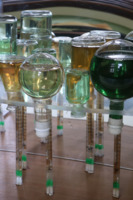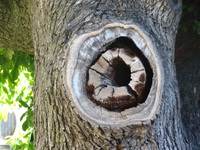Items
Site
The Medicine Chest
keywords is exactly
lacuna
-

Forest
"The bottles and pipettes in 'Forest' were originally sourced from the storage rooms of the Chemistry department, where they awaited disposal. This cabinet responded to the lacuna of indigenous material represented by the chest and addressed this imbalance by filling the bottles with teas made from local medicinal plants. Staging the bottles and pipettes to simulate a forest references the prejudice of Burroughs, Wellcome and Co (BWC) against these natural remedies, ‘purifying’ them through laboratory processes before they were deemed trustworthy and marketable. This process also occluded the original source of the remedies and sowed the seeds of biopiracy. The various items of glassware in this cabinet were filled with a selection of infusions made from Balotta africana, Sutherlandia frutescens, Agathosma crenulata, Melianthus major, Mentha longifolia, Petroselinum crispum, Hypoxiz villosa and Salvia officinalis" (Liebenberg 2021: 255). -

Lacuna (Part one)
"It is interesting to note that the botanical origins of most of these medicines were from outside of Africa, especially if one considers the long history of the Cape as a point on the trade routes where ill sailors regularly disembarked and drew on the knowledge of the Khoekhoe traditional healers for treatment and herbal cures (Laidler & Gelfand 1971: 44). The Cape flora offered a plenitude of medicinal resources and these healers (who were skilled in botany, surgery and medicine) used them in a variety of healing practices . The exclusion of local botanical remedies in the BWC No. 254 medicine chest can be attributed to many factors" (Liebenberg 2021: 67). -

Lacuna (Part two)
An ill English Oak on Hiddingh Campus, Michaelis School of Fine Art, University of Cape Town. English oaks were first brought into the country by the early settlers and were one of the first exotic tree species to be planted in South Africa, shortly after Van Riebeek’s arrival in 1652. He explained that in South Africa, these trees do not grow as old as they would have in Europe. The high temperatures cause these trees to grow faster than their species back home, and because of this, their centers start rotting over an extended period of time. The center part of the wood – the heart – is affected by this occurrence and hollowed out over time.


